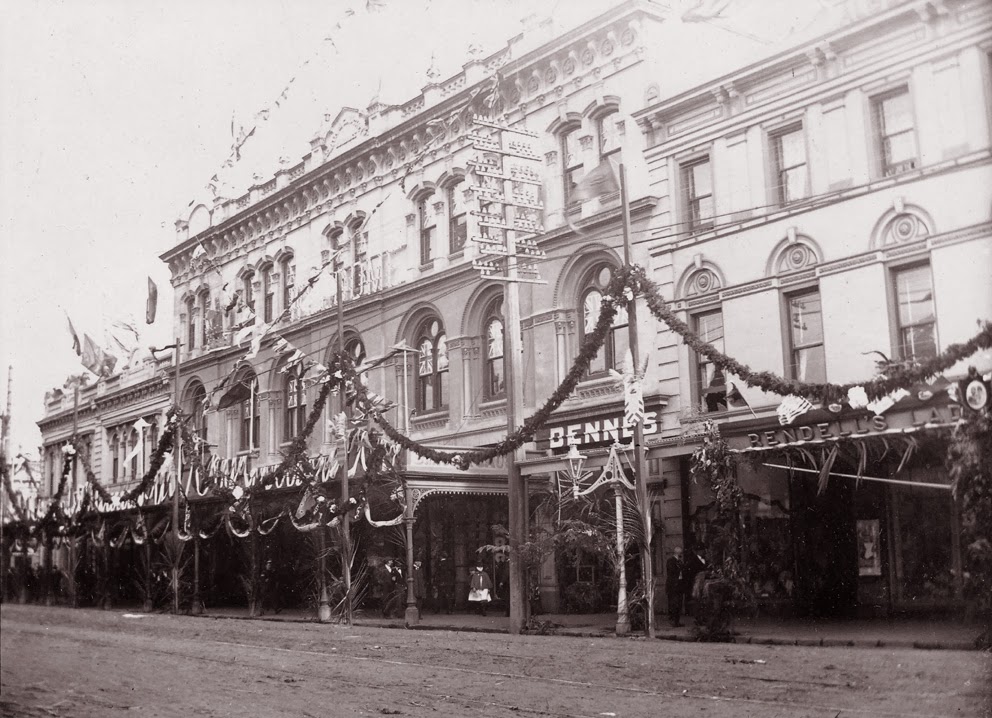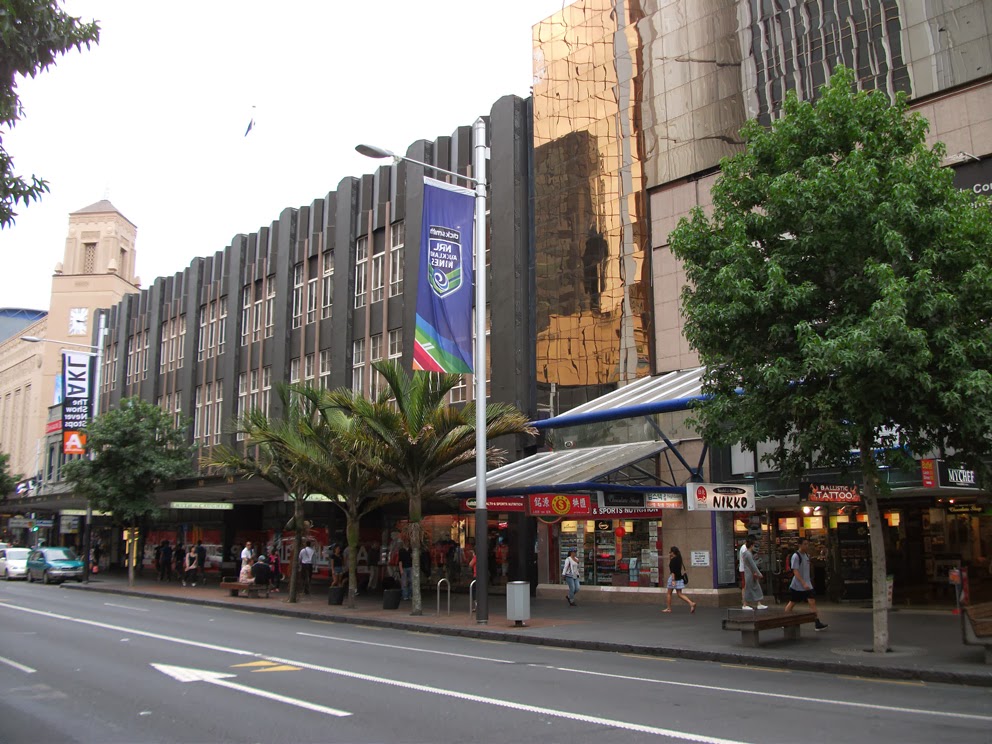 |
| "1901 - 2014 - Then and Now" - a Photo Montage of Smith & Caughey's Block on Queen Street, Auckland |
My Blog from June 2013 "Remembering the 1901 Royal Visit to Auckland, New Zealand" featured a number of images from an historic old album in my possession, the photographs being taken around 1901 by a Mr R.H. Cook. I have as yet been unable to ascertain anything more about Mr Cook other than that he appears to have been an employee of "Smith & Caughey Ltd" in Queen Street Auckland, a member of the West End Rowing Club, and possibly residing in or very close to Ponsonby. There appears to be no record of his burial in Auckland. I would be very interested in any further information on Mr Cook. Has anyone access to old Electoral Rolls?
 |
| A dapper looking Mr R.H. Cook |
I thought it would be fun during my recent holiday to Auckland in the North Island of New Zealand to retrace Mr Cook's footsteps and recreate some of his images. This often proved problematic due to redevelopment and a multitude of multi-storied buildings blocking the original perspective. But still, we are fortunate that the location of the original images can still be discerned or at least estimated. Further images from Mr Cook's album will be featured in the future. So let us now compare Mr Cook's Auckland of 1901 with that of 2014. All images are from my own collection (click for a larger view) :

The original image is taken from an upper window in "Smith & Caughey's" Department Store and shows Imperial Troops on horseback parading up Queen Street in February 1901. The only point of reference now is the old Auckland Savings Bank building, now a McDonald's Restaurant but preserving the magnificent moulded ceiling from the original banking chamber.
This view of the Auckland Public Library and Municipal Offices on the corner of Kitchener Street and Wellesley Street East is just not possible today due to high-rise buildings having been built on the vacant land in the foreground. It would appear to have been taken from Lorne Street. Opened in 1887 and designed by Melbourne architects John H. Grainger and Charles A. D'Ebro in the "French Chateau style", the original unobstructed perspective along Lorne Street would have looked rather impressive.


A zoom in of the clock tower of the former Auckland Public Library on Kitchener Street together with a view of the old Park Hotel on the corner of Wellesley Street (East) and (the then) Rutland Street which now forms part of Mayoral Drive.

The Ceremonial Arch erected on Wellesley Street (East) outside the old Auckland Public Library and Municipal Chambers during the visit of HRH Prince George, Duke of Cornwall & York and HRH Princess Mary, Duchess of Cornwall & York (later King George V and Queen Mary) to New Zealand in June 1901. In April 2014 we shall be welcoming his Great Great Great Grandson, Prince George, to New Zealand. But the days of erecting ceremonial and floral arches for visiting royalty are now a thing of the past.

A view of "Smith & Caughey's" Department Store on Queen Street. The whole of Queen Street had been decorated for the visit of HRH Prince George and HRH Princess Mary in June 1901. The only point of reference now is barely discernable, being the end building (with four windows) of the smaller building at far left in the 1901 photo.
The ornamental pediment and other decorative elements have however been stripped from the far end façade, something that was common during the 1930's to 1950's, usually in an effort to project a "modern" and streamlined image. But crumbling masonry from lack of maintenance was also sometimes to blame. While some old buildings now at least sport an interesting Art Deco style façade others are unfortunately far less of an 'architectural ornament' to the streetscape. This phenomenon was however not unique to New Zealand but world-wide. The Germans, who before the war enthusiastically "stripped" many elegant old 19th century era and Art Nouveau style buildings of their then 'outdated' architectural features, called this process "entschandelung", literally meaning "re-figurement".
The Auckland Wharf at the very foot of Queen Street, also decorated for the Royal Visit in June 1901, a ceremonial arch just visible at the end of the wharf. There is no point of reference today on what is now known as Queen's Wharf. A number of old commercial and warehouse buildings still survive at far left but are obscured by modern buildings. Behind me in the 2014 image is a great piece of modern architecture known as "The Cloud" with "Shed 10" alongside, being a refurbished historic wharf cargo shed, now used not only as an events centre but as Auckland's primary cruise ship terminal.

A fountain in Albert Park. But for the missing urns in the foreground and the skyscrapers now looming over the horizon this scene is remarkably similar today.

The Band Rotunda in Albert Park, again looking remarkably similar. The trees in the background hide the inevitable modern high rise commercial buildings and inner city apartments.
A close-up of the above fountain in Albert Park. The view of Mount Eden has been more or less obliterated by mature trees and modern buildings, in this case on Princes Street and belonging to the University of Auckland.



This image of the Waitemata Harbour looking across to Devonport proved very difficult to achieve the same perspective, being taken from the Wynyard Quarter Wharf. The original image appears to have been taken from a higher elevation and possibly further back. In the modern image the far right "mount" at the end of the Devonport Peninsula is obscured by the boat alongside the Viaduct Events Centre.

Finally, a view of what is most likely Mr Cook's dog taken on College Hill looking up towards the intersection with Ponsonby Road and Jervois Road. The building at rear in the 1901 image, complete with upper veranda, is the original Ponsonby Club Hotel, built in 1875. The name of the owner, Mr SW Buck, appears on the pediment.
A close-up of the Ponsonby Club Hotel. The present tavern on the site, being built in 1937, is known as "The Gluepot", a name that appears to have come into common usage even before the old building was demolished.



















Wow, really interesting post, esp as I know all those places well. I went to Uni in Auckland. I still think that the art gallery along with the custom house, is one of the more architecturally pleasing buildings in the city.
ReplyDeleteThank you for your comments, mush appreciated. It took me 12 months to achieve but I had great fun researching and putting this post together. I really cannot understand why the beautiful Art Gallery building has been "boxed in" from Lorne Street, this appears not to have happened until well into the 20th century.
DeleteYes, I agree. That whole hill coming down from Lorne St to Queen street would have been a most beautiful park and extension of Albert Park in a way. The gallery has presence in the vintage photo sitting on the hill - something which is lost today.
ReplyDelete